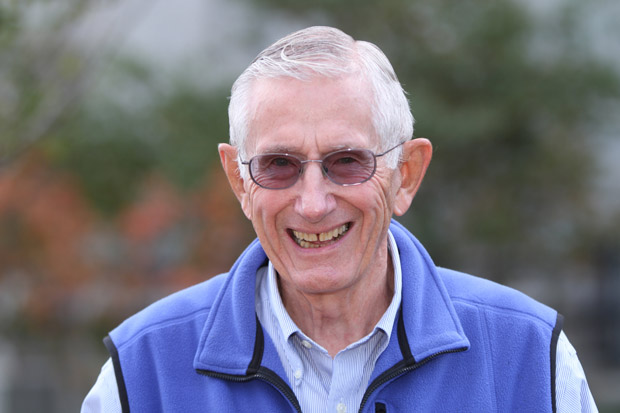It’s about goals, he said.
“If our goal is to pray, reverence and serve God in this world and the next, why are people so reticent about going there and being with him?” he asked. “If your goals are wealth, prestige, fame, relationships — well, then you’re in trouble.”
A “wise doctor” told him in medical school that it’s not unhealthy to think about one’s own death. He recalls finding the advice morbid at the time, but said over the years it has helped to sharpen his focus on what’s important. And working in hospice care helped him further embrace it, he said.
[hotblock]
A parishioner of Assumption in downtown St. Paul, the 77-year-old Thalhuber spent 40 years practicing hospice care, although he said it was a specialty he “backed into.” When he was a medical resident at the University of Minnesota, a colleague invited him to a St. Paul hospice home now known as Our Lady of Peace.
A year later, in 1968, he began serving as its medical director, a position he held until 2009, eight years after retiring from his private practice.
“It was there that I learned about the dying patient,” he told The Catholic Spirit, newspaper of the Archdiocese of St. Paul and Minneapolis. “What they taught me about my own mortality is to trust and be grateful. And trust trumps all. When patients trusted, and were grateful for what they had accomplished and who they were, and knew who they were, it was a very powerful experience.”
Hospice — in its contemporary form — emerged in the U.S. in the 1960s, and it felt like cutting-edge medicine to the young doctor, because it defied what he had been taught was medicine’s goal: curing the sick. In 1983, Thalhuber also became the hospice medical director at Midway Hospital, a position he continued with HealthEast after Midway merged with other area health care facilities to create the health care system in the late 1980s.
Hospice allows people the opportunity to offer what one of Thalhuber’s HealthEast colleagues termed the “four gifts”: The opportunity to say “I’m sorry,” “I love you,” “thank you” and “goodbye, I’ll be OK.”
Based on the work of psychiatrist Elisabeth Kubler-Ross, known for identifying the five stages of grief, the “four gifts” are monumental for patients and families preparing for death, Thalhuber said.
The first aim of hospice is controlling a patient’s symptoms, he said, after which a person can focus on reaching acceptance through accepting the “four gifts.”
The order is important, Thalhuber said, noting the final “I’ll be OK” is crucial. “For the dying patient to tell their kids or their spouse, ‘I’m going to be OK’ — wow, dynamite,” he said.
[hotblock2]
Hospice “was hands down the most fulfilling aspect of my practice of medicine,” he said. “The best. I learned so much. I was so privileged.”
It taught him “how positive death can be,” he said. “It sounds strange, but it’s as positive as being born, it’s as positive as being a teenager, it’s as positive as getting married — probably more so because you’re fulfilling your purpose in life.”
He encourages people to think about their own death, and for people with terminal illnesses, to consider hospice sooner rather than later.
“It’s going to happen,” he said of death. “To deny dying is to deny humanness, and that’s what causes the frustration.”
He added: “To leave the tests, and the CAT scans and the MRIs, the IVs, you go from high tech to high touch,” he said. “Hospice is high touch. A marvelous program.”
Thalhuber is disturbed by the traction euthanasia has gained in the U.S. in recent years, not only because his Catholic faith forbids it.
“What they miss out on is growth at the end of life,” he said. “Every stage of life has growth that’s essential. … Dying is a part of life. There is an opportunity there for growth. How can you grow if you kill yourself?
“The reason people do that is because they’re afraid and they want to be in control,” he added. “But if you accept what’s going on, there’s just so many examples of how people grow at the end of life.”
A few years before retiring, Thalhuber began praying with his patients, a practice he wishes he would have started earlier. He says it’s one of the best things he did.
“That had nothing to do with religion. The key was finding out where the patient was spiritually, what their values were spiritually. Almost all had a degree of spirituality, and if you could tap into that, and then just join them in praying along that vein, the floodgates opened up,” he said. “Praying with the patient was powerful.”
Married to his wife, Dot, for 50 years, father to five and grandfather to 12, Thalhuber said his Catholic faith gave him good grounding for hospice work. He grew up in St. Paul attending St. Mark Parish and went to school at what was then St. Thomas Military Academy and the College of St. Thomas before entering medical school at yet another Catholic institution, St. Louis University in St. Louis.
“My Catholic training definitely put me in a position to better appreciate my spirituality so to develop my relationship with my God,” he said, adding that it also helped to believe in life after death. “It greatly facilitated my ability as a physician to be with the dying patient.”
***
Wiering is editor of The Catholic Spirit, newspaper of the Archdiocese of St. Paul and Minneapolis.
PREVIOUS: At hearing, stronger global response urged for Europe’s refugee crisis
NEXT: Energetic Georgia priest wins Catholic Extension’s Lumen Christi Award




Share this story